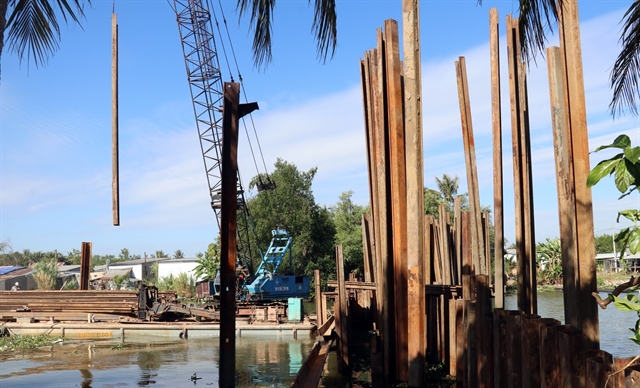 Society
Society

The Ministry of Agriculture and Rural Development (MARD) has recently proposed an aid package worth VNĐ515.3 billion ($22 million) to deal with drought and saltwater intrusion in 2020.

|
| A dam to prevent salinity is being built in Vĩnh Hòa Hiệp Commune, Châu Thành District in the southern province of Kiên Giang. It’s should be finished next month. — VNA/VNS Photo Lê Huy Hải |
HÀ NỘI — The Ministry of Agriculture and Rural Development (MARD) has recently proposed an aid package worth VNĐ515.3 billion ($22 million) to deal with drought and saltwater intrusion in 2020.
This forms part of activities to implement Directive No 04/CT-TTG dated January 22, 2020 by the Prime Minister on measures to mitigate drought, water shortages and saltwater intrusion.
The aid package aims to help carry out urgent solutions to prevent and cope with drought, water scarcity and saltwater intrusion. These include pumping water, dredging canals, maintaining irrigation works, building temporary embankments to retain freshwater, digging ponds and wells, extending the water pipeline network, purchasing equipment for water filtration and storage, and delivering water to residential areas, hospitals and schools facing water shortages.
Due to the lack of rain in 2019, most irrigation reservoirs nationwide are only between 50 – 80 per cent capacity. The reservoir at the upper source of the Hồng River in Thái Bình is around 60 per cent full, while Hòa Bình Lake is at 63 per cent, the lowest in the past 30 years.
Those in the central region are only 15-30 per cent full. The water level in the Mekong River is lower than in 2015-2016, which recorded the worst salinity.
According the MARD, solutions to prevent drought, saltwater intrusion have been proven effective. Though the Mekong Delta region suffered more severe salinity than in 2015-2016, only 49,800 hectares of rice crops in 2019-2020 were damaged, accounting for 1.81 per cent of the whole region. At the peak, around 96,000 households lacked clean water, compared with 114,000 households in 2015-2016.
All rice crops in the Central Highland region and the northern region receive water from irrigation reservoirs with a combined capacity of 2.68 billion cubic metres.
Drought and water shortages are predicted to continue until May in the Central Highlands, and August in the central region.
Previously, an aid package of VNĐ530 billion (over $22.7 million) was approved by Prime Minister Nguyễn Xuân Phúc to help eight provinces in the Mekong Delta deal with drought, water scarcity and saltwater intrusion, which have been taking a heavy toll on the country’s agricultural production hub.
Quảng Nam’s efforts
The central province of Quảng Nam is also making great efforts to build canals and temporary embankments to retain fresh water in the Vu Gia and Thu Bồn rivers.
It aims to ensure water resources for dozens of hectares of rice and farm produce.
The province has experienced prolonged hot weather recently and river levels have gradually fallen. Moreover, saline intrusion is becoming more and more serious, affecting water for daily use and manufacturing.
The saline water prevention embankment in Điện Phong Commune, Điện Bàn District is one of the main embankments in the area.
Nguyễn Ngọc Châu, deputy director of the Điện Bàn Irrigation Branch, said three pumping stations were working along the Vĩnh Điện River to irrigate about 1,700ha of rice and farm produce in Hội An and Điện Bàn, and supply water for thousands of local residents.
Saline water has been encroaching since the beginning of this year so the town invested more than VNĐ1.5 billion (US$65,200) on building the embankment.
However, the water level in the Thu Bồn River has fallen over the past two months causing supply difficulties.
Trần Huy Tường, head of the Duy Xuyên District Agriculture Division, said to cope with the problem, the district had fixed seven reservoirs, 25 dams, 40 pumping stations and hundreds of kilometres of channels to supply water for more than 3,800ha of rice, nearly 2,000ha of farm produce and for daily use.
Besides, deputy director of the Quảng Nam Irrigation Exploitation Co Ltd Đào Văn Thiên said the company had been building dams since the beginning of the year to prevent saline intrusion. — VNS




